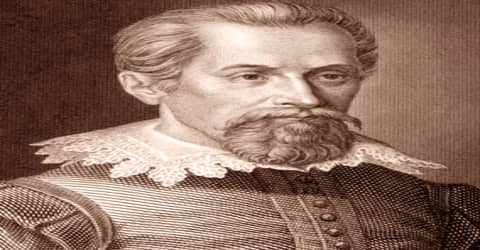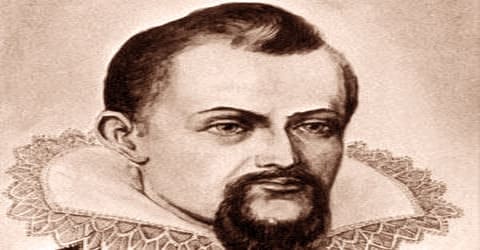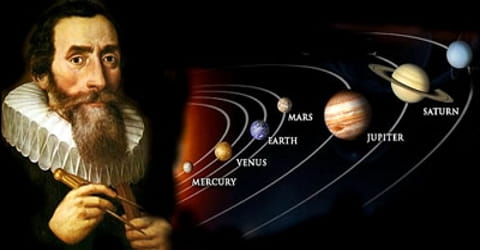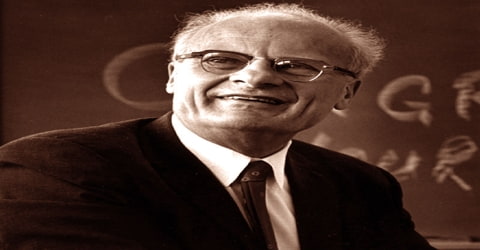Biography of Johannes Kepler
Johannes Kepler – German Mathematician, Astronomer, and Astrologer.
Name: Johannes Kepler
Date of Birth: December 27, 1571
Place of Birth: Free Imperial City of Weil der Stadt, Holy Roman Empire
Date of Death: November 15, 1630 (aged 58)
Place of Death: Free Imperial City of Regensburg, Holy Roman Empire
Father: Heinrich Kepler
Mother: Katharina Guldenmann
Siblings: Christoph, Matthias
Spouse/Ex-: Barbara, Susanna Reuttinge
Scientific Career: Astronomy, Astrology, Mathematics, and Natural Philosophy
Discoveries/Inventions: Refracting Telescope
Early Life

Johannes Kepler (/ˈkɛplər/; German: [joˈhanəs ˈkɛplɐ, -nɛs -]) was born on December 27, 1571, in Weil, Germany. He was the son of Heinrich and Katharina Guldenmann Kepler. His father was a mercenary (a soldier serving only for money). Although a member of the Protestant faith, his father helped put down a Protestant uprising in the Low Countries (Belgium, Holland, and Luxembourg). Kepler’s parents allowed him to watch the great comet of 1577 and an eclipse (passing into shadow) of the Moon. Kepler was a sickly child but an excellent student. At thirteen he entered a religious training school at Adelberg, Germany.
Following Kepler’s graduation from the University of Tübingen in 1591, he became interested in astronomy, particularly the theories of Nicolaus Copernicus (1473–1543), who stated that the Earth moved around the Sun in a circle. The University of Tübingen recommended Kepler for the post of the “mathematician of the province” in Graz, Austria. He arrived there in 1594 and began composition of the almanac, in which the major events of the coming year were predicted. His first almanac was a success. The occurrence of two events that he had predicted, an invasion by the Turks and a severe winter, established his reputation. In 1597 Kepler married Barbara Muehleck. Of their five children, only one boy and one girl reached adulthood.
Kepler is a key figure in the 17th-century scientific revolution. He is best known for his laws of planetary motion, based on his works Astronomia nova, Harmonices Mundi, and Epitome of Copernican Astronomy. These works also provided one of the foundations for Isaac Newton’s theory of universal gravitation.
Johannes Kepler was a famous German mathematician and astronomer who discovered the ovoid movements of the planets around the sun. The first astronomer to state the fundamental laws of planetary motion, Kepler was also known for his works in geometry, optics, and philosophy. His significant achievements have been the discovery of the Kepler’s Star, the ‘Astronomia Nova’ and also the ‘Kepler Conjecture’. For being one of the prominent figures in astronomy, a lot of astral elements were named after him such as ‘Kepler’s crater on Mars’, ‘The Kepler Moon crater’ etc. Apart from astronomy, Kepler concentrated on mathematics and the evolution of geometry. He came up with ‘Kepler Triangle’ and the ‘Kepler Problem’, both of which, published in three parts, studied various aspects of geometric progression, characterized by the ‘Pythagorean Theorem’ and the ‘Golden Ratio’. As a part-time amusement, he even studied astrology and published a few works on the subject such as ‘De Fundamentis Astrologiae’ and ‘Dissertatio cum Nuncio Siderio’. He worked for Tycho Brahe, a Danish nobleman and even served as an advisor to Emperor Rudolph II during his lifetime. Scroll down to learn more about this interesting personality.
Childhood, Family and Educational Life
Johannes Kepler was born on December 27, 1571, to Heinrich Kepler and Katharina Guldenmann in the Stuttgart region of Germany. By the time Johannes was born, he had two brothers and one sister and the Kepler family fortune was in decline. His family was believed to be very wealthy but by the time Kepler was born, the wealth in the family had declined drastically. Kepler’s father, Heinrich Kepler earned his living as a mercenary and left the family when Johannes was just 5 years old. His mother, Katharina Guldenmann was an herbalist and a healer, who later even attempted witchcraft for a living. Born prematurely, Johannes claimed to have been weak and sickly as a child. Nevertheless, he often impressed travelers at his grandfather’s inn with his phenomenal mathematical faculty.
Kepler’s family was Lutheran and he adhered to the Augsburg Confession a defining document for Lutheranism. However, he did not adhere to the Lutheran position on the real presence and refused to sign the Formula of Concord. Because of his refusal, he was excluded from the sacrament in the Lutheran church. This and his refusal to convert to Catholicism left him alienated by both the Lutherans and the Catholics. Thus he had no refuge during the Thirty-Years War.
At age six, he observed the Great Comet of 1577, writing that he “was taken by [his] mother to a high place to look at it.” In 1580, at age nine, he observed another astronomical event, a lunar eclipse, recording that he remembered being “called outdoors” to see it and that the moon “appeared quite red”. However, childhood smallpox left him with weak vision and crippled hands, limiting his ability in the observational aspects of astronomy.
In 1589, after finishing grammar and Latin school, Kepler attended the Tubingen Stift at the University of Tubingen. It was here he proved himself to be an intelligent mathematician and earned the reputation of a skillful astrologer. He also studied philosophy and theology under two renowned personalities — Vitus Muller and Jacob Heerbrand. At the University of Tubingen, Kepler learned the Copernican and the Ptolemaic system of planetary motion. He believed in the Copernican system and maintained that the Sun was the chief source of motive power in the universe. Towards the end of his education, Kepler was keen on becoming a minister but gave up his plans as soon as he was offered the job of a professor of mathematics and astronomy at the Protestant school in Graz. Kepler accepted the position in 1594, at the age of 23.

Personal Life
In December 1595, Kepler was introduced to Barbara Müller, a 23-year-old widow (twice over) with a young daughter, Regina Lorenz, and he began courting her. Müller, an heiress to the estates of her late husband’s, was also the daughter of a successful mill owner. In the first year of his marriage, Kepler had two daughters, both of whom died in infancy. The couple also had three more children in the following years. However, Barbara’s health deteriorated and she passed away in 1612.
On October 30, 1613, Kepler remarried. This time, he married 24-year-old Susanna Reuttinger, after considering 11 matches before her. The first three children born from this marriage died in infancy. It is said, the second marriage was a happier one than the first. In between all these emotional upheavals, Kepler’s mother was accused of practicing witchcraft and was imprisoned for fourteen months. Throughout her trial, Kepler was said to be by her side.
Career and Works

During his teaching career at the Protestant school of Graz, Kepler stated that he had an ‘epiphany’ about the cosmic plan of the structure of the universe. In the defense of his Copernican views, Kepler demonstrated the periodic conjunction of the planets, Saturn and Jupiter in the zodiac. He also addressed the polygonal ratios between the planets, stating that he was sure of the geometry of the universe.
Kepler sought the job of assistant to Tycho Brahe (1546–1601), astrologer (one who interprets the positions of stars and planets and their effect on human affairs) and mathematician to Rudolph II (1552–1612), in Prague, Czechoslovakia. Kepler took his new position in 1600. When Brahe died the following year, Kepler was appointed to replace him. His first job was to prepare Brahe’s collection of studies in astronomy for publication, which came out between 1601 and 1602.
He found that each of the five Platonic solids could be inscribed and circumscribed by spherical orbs; nesting these solids, each encased in a sphere, within one another would produce six layers, corresponding to the six known planets—Mercury, Venus, Earth, Mars, Jupiter, and Saturn. By ordering the solids selectively—octahedron, icosahedron, dodecahedron, tetrahedron, cube—Kepler found that the spheres could be placed at intervals corresponding to the relative sizes of each planet’s path, assuming the planets circle the Sun. Kepler also found a formula relating the size of each planet’s orb to the length of its orbital period: from inner to outer planets, the ratio of increase in orbital period is twice the difference in orb radius. However, Kepler later rejected this formula, because it was not precise enough.
In 1604, Kepler observed a bright new evening star and could not believe his eyes when he saw a nebula. Such a supernova could only be sighted in a gap of 800 years. It was said that it was sighted once during the rise of the Charlemagne and once during the birth of the Christ. After this unique sighting, Kepler addressed the star’s astronomical properties and even began studying celestial spheres. His ideas on the parallax and astronomy brought him to the forefront and helped him build his image even further.
Kepler also published two important works while in Linz. In the Harmonice Mundi (1618) his third law was announced. It stated that the average distance of a planet from the sun, raised to the third power, divided by the square of the time it takes for the planet to complete one orbit, is the same for all planets. Kepler believed that nature followed numeric relationships since God created it according to “weight, measure, and number.” Kepler used the same idea in describing geometry (the study of points, lines, angles, and surfaces). Kepler’s second work, the Epitome astronomiae Copernicanae (published 1618–21), proposed a physical explanation of the motions of planets, namely, “magnetic arms” extending from the sun.
Kepler wandered over Europe in the last three years of his life. He was in Ulm, Germany, when his Tabulae Rudolphinae (1628) was published. It not only added the positions of over two hundred stars to those contained in Brahe’s published works, but it also provided planetary tables that became the standard for the next century.
Most of Kepler’s theories based on the Copernican system stemmed from his beliefs about the connection between the scientific and theological views of the universe. Thus, he came up with his first and probably one of the most controversial astronomical works called ‘Mysterium Cosmographicum’ in 1596. This built Kepler’s reputation as a highly skilled astronomer. Kepler made slight modifications to his publications later and even used this works as a basis for his future projects. He released a second version of ‘Mysterium’ in 1621, improving and correcting the details from the first edition.
In 1621, Kepler published an expanded second edition of Mysterium, half as long again as the first, detailing in footnotes the corrections and improvements he had achieved in the 25 years since its first publication.
In terms of the impact of Mysterium, it can be seen as an important first step in modernizing the theory proposed by Nicolaus Copernicus in his “De Revolutionibus orbium coelestium”. Whilst Copernicus sought to advance a heliocentric system in this book, he resorted to Ptolemaic devices (viz., epicycles and eccentric circles) in order to explain the change in planets’ orbital speed, and also continued to use as a point of reference the center of the earth’s orbit rather than that of the sun “as an aid to calculation and in order not to confuse the reader by diverging too much from Ptolemy.” Modern astronomy owes much to “Mysterium Cosmographicum”, despite flaws in its main thesis, “since it represents the first step in cleansing the Copernican system of the remnants of the Ptolemaic theory still clinging to it.”
Major Works –
- Astronomia Nova
- Astronomiae Pars Optica
- Mysterium Cosmographicum
- Somnium
- A New Year’s Gift of Hexagonal Snow
- Kepler Conjecture
- Law of Continuity
- Kepler’s Laws of Planetary Motions
- Epitome of Copernican Astronomy
- Harmonices Mundi
- Rudolphine Tables
Beyond his role in the historical development of astronomy and natural philosophy, Kepler has loomed large in the philosophy and historiography of science. Kepler and his laws of motion were central to early histories of astronomy such as Jean-Étienne Montucla’s 1758 Histoire des mathématiques and Jean-Baptiste Delambre’s 1821 Histoire de l’astronomie moderne.
Death and Legacy
Kepler died before observing the transits of Mercury and Venus which he was waiting eagerly for. He died on November 15, 1630, in Regensburg, Germany after a brief period of illness. For many years, Kepler’s laws were viewed with skepticism.
Several astronomers tested Kepler’s theory, and its various modifications, against astronomical observations. Two transits of Venus and Mercury across the face of the sun provided sensitive tests of the theory, under circumstances when these planets could not normally be observed. In the case of the transit of Mercury in 1631, Kepler had been extremely uncertain of the parameters for Mercury and advised observers to look for the transit the day before and after the predicted date. Pierre Gassendi observed the transit on the date predicted, a confirmation of Kepler’s prediction. This was the first observation of a transit of Mercury. However, his attempt to observe the transit of Venus just one month later was unsuccessful due to inaccuracies in the Rudolphine Tables. Gassendi did not realize that it was not visible from most of Europe, including Paris. Jeremiah Horrocks, who observed the 1639 Venus transit, had used his own observations to adjust the parameters of the Keplerian model, predicted the transit, and then built apparatus to observe the transit. He remained a firm advocate of the Keplerian model.
Many music compositions and opera pieces for Kepler such as ‘Die Harmonie der Welt’ were written by famous composers. In 2009, to honor Kepler’s contributions in the field of astronomy NASA announced the ‘Kepler Mission’.
Information Source:
















